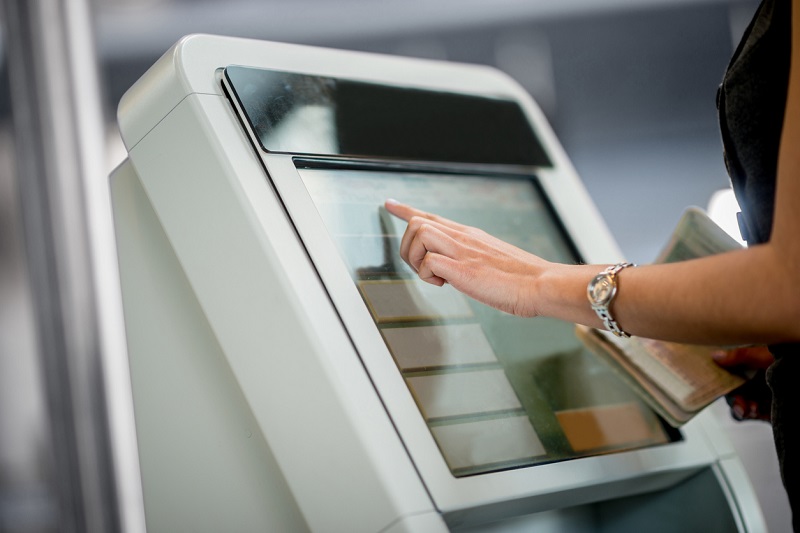Self-service digital and interactive kiosks have become increasingly popular over the past decade, but especially over the past several years. This growing popularity has led many companies to consider implementing a kiosk program of their own.
Unfortunately, finding information about the cost of digital kiosks can be difficult. There are several reasons for this, but the biggest is that the cost of a digital kiosk can vary widely – anywhere from $1500 to $20,000, in fact , meaning there’s no accurate way to give an average.
Common Kiosk Pricing Factors
While finding exact pricing may not be easy without requesting a quote, there are specific factors that affect the price of digital kiosks. Understanding what they are can go a long way toward helping set appropriate expectations when researching kiosks and submitting RFQs to kiosk manufacturers.

Kiosk Enclosures
The kiosk enclosure is the “body” of the kiosk. For something small, like a tablet kiosk, the enclosure can be minimal, which keeps the cost down. It could be something as simple as a stainless steel counter-mount tablet frame and stand that holds the kiosk in place for users.
However, full-size, freestanding kiosks are much more costly, as they use hundreds or even thousands of dollars worth of metal to fabricate the enclosure, and each panel and piece adds more to the cost of manufacturing. Additionally, some larger kiosks can be manufactured for outdoor environments, which requires that they be built to withstand extreme weather conditions, adding more to their manufacturing cost.
Kiosk Displays
The type of display selected for a kiosk can change the price dramatically.
- Tablets: These include iPads and Android tablets and are the most inexpensive type of display, because they also serve as all-in-one solutions that include the operating system, a basic enclosure (the tablet itself), as well as the display.
- Static digital monitors: A static monitor might be used to display a directory, for example, and may rotate through various screens automatically, but it is not touch-sensitive and can’t be used to look up or scroll through information directly.
- Interactive touchscreen displays:
Components & Integrations
Kiosk hardware is the enclosure plus anything integrated into it, inside or out, that can be physically touched; essentially, if it’s not a computer program, it’s hardware. This includes kiosk components like an integrated computers, credit card readers, ticket and receipt printers, bill collectors, fingerprint scanners and more. The most basic tablet kiosks may not require any hardware other than the stand and frame, making them the least expensive type of kiosk to manufacture. More complex kiosks, like those that dispense products like SIM cards, or allow financial transactions and purchases, require many more components, each of which add to the cost.
Kiosk Software
Digital kiosk software is the brain of the kiosk. It tells the kiosk’s components what to do, and how to do it. Its can be as simple that used to create and organize a list of names and office locations in a directory, or as complicated as that used in busy quick-service restaurants for ordering and self-payment.
Kiosk Type and Functionality
There are three main kiosk form factors: floor mounted/freestanding, counter-mounted, and wall-mounted. Each comes in multiple sizes with varying functionality that can greatly affect the cost.
Scale and Order Size
As with many items, the more you purchase, the bigger the discount. Multi-deployment digital kiosk programs can receive discounts of 5%-40%, depending on the type of kiosk and total order size.
Kiosk Installation
Tablet kiosks with minimal mounting requirements are the least expensive to install. Most freestanding kiosks have minimal installation costs associated with them, too. Wall mounted kiosks tend to be the most expensive, because they require proper hanging and support. Recessed wall-mounted kiosks, like digital directories, and complex multi-screen video walls tend to be the most expensive to install.
Kiosk Maintenance
Purchasing a kiosk service and maintenance contract adds to the total cost of a kiosk program, but it also helps protect what can be a very significant investment. The cost of maintenance varies depending on the options chosen, but may include remote diagnostics and troubleshooting, content management and storage, usage analytics reporting, hardware repair and replacement and software updates.
H2 Kiosk Types Prices
1. Freestanding kiosk price
These kiosks have the greatest price range, because they vary so much in size. Some indoor kiosks are quite slim and compact, and therefore use a minimum of materials. However, there are also much larger floor standing kiosks, like mall directories and advertising kiosks, that require more components, integrations, materials and manufacturing time, making them a higher priced option.

2. Wall-mounted kiosk price
These also have quite a price range. Simpler wall-mounted kiosks with static (non-interactive) displays are on the low end, while touchscreen video walls are much more expensive. Hotels and conference centers often install large wall mounted, information kiosks in their lobbies to show weather, traffic, and local area information.
3. Counter-mounted kiosk price
On average, these kiosks are some of the least expensive to manufacture and deploy. They are always compact, and more often than not, and because of their size, even touchscreen displays tend to be on the more affordable side. A mounting system, operating system and software will generally need to be added. Depending on the use case, components like credit card readers may be required, too. These are common in office and hospital canteens, as well as some hotel gift shops.
4. Tablet Kiosk Price
Tablet kiosks are universally small, and combine the display, operating system, and basic enclosure, making them the least expensive type of basic interactive digital kiosk. A mounting system and software are required, and sometimes various components required for bill payment are added as well. Medical offices and corporate offices often use tablet kiosks to allow visitors and guests to check themselves in and our, rather than having to rely on a front desk employee for assistance.
5. Touch Screen Kiosks Price
Touchscreen kiosks, including those with capacitive displays, allow users to interact with them much as they would a tablet or smart phone. The technology used in interactive displays is much more complex, making them the most expensive, however, they offer much more utility to businesses and their customers, visitors and guests. Touch screen kiosks are often deployed in places like museums or as part of a “smart city” program to help visitors more easily navigate a given area and print transportation or exhibit tickets.
6. Indoor and Outdoor Kiosks Price
Outdoor kiosks are almost always more costly than indoor kiosks. This is because they require more expensive materials to manufacture in order to ensure that they are water, heat, wind and cold-proof.
Are digital kiosks worth the cost?
For most organizations, the answer is yes. Kiosks are available in such a wide range of sizes, types and form factors that they can be an affordable option for almost any business, especially given their many benefits, including:
- Lower overhead/reduced costs: Kiosks often reduce operational costs, saving organizations money. Visitor management kiosks allow visitors to sign themselves in and out of an office complex rather than waiting on a front desk employee. Self-checkout kiosks let customers pay for their items and be on their way, without any additional assistance from cashiers.
- Greater end-user satisfaction: Deploying interactive kiosks allows organizations to give customers and guests access to information and assistance that may not otherwise be readily available. Instead of having to track down an associate or other team member to find out more about a product or promotion they can instead use the kiosk. In restaurants or other food service environments, ordering and paying can be simplified. In a museum, visitors can find their way around the facility via a wayfinding kiosk, instead of having to ask for help. This leads to a better customer or visitor experience, and increases the chances they they will return in the future.
- Increased revenue: Digital kiosks give businesses more opportunities to talk to their customers directly, and implement selling programs more consistently than they might be able to with live customer associates. For instance, quick-service restaurants (QSRs) that utilize self-order/self-pay kiosks nearly always see an increase in sales as it makes upselling and cross-selling items much simpler. Digital kiosks also let QSRs focus on the most profitable items via direct promotion.
Why Choose REDYREF for Kiosk Manufacturing
With more than 100 years of kiosk manufacturing experience, REDYREF has the expertise and resources to make almost any type of interactive kiosk a reality. And because we keep most processes in-house – from design to powder coating – we are able to do it while keeping costs down. Controlling the entire manufacturing process from start to finish means we are able to prototype products quickly, and make changes as needed throughout the process as requirements change. This gives our customers the flexibility they need to make their kiosk deployment as successful as possible. From interactive kiosks, to digital signage and touchscreen building directories, REDYREF can “build everything kiosk™”.


